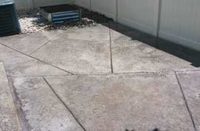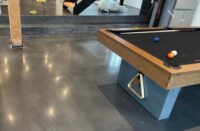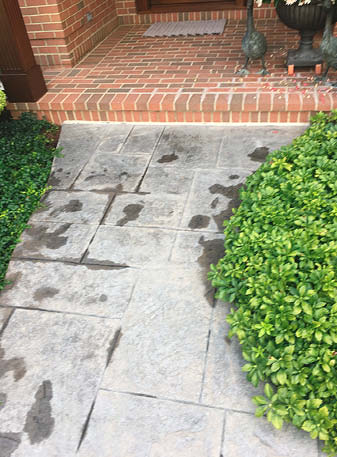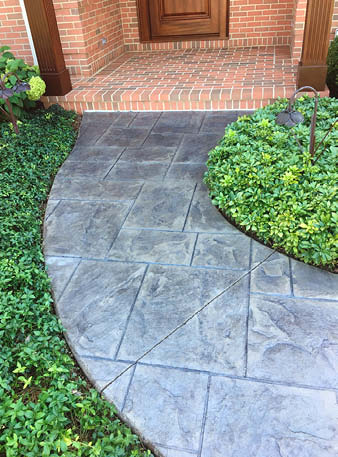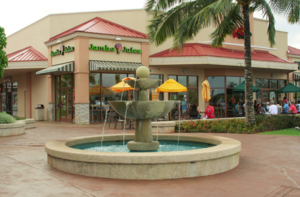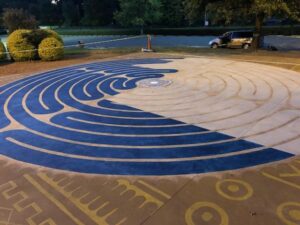
Rick Ogden, owner of Rick Ogden Concrete Construction in Pryor, Oklahoma, traces his start in the decorative concrete industry to the late 1970s. It was then when he stained his first floor. Learning concrete color restoration strategies took years.
“The stain went away the first winter,” he recalls. “Of course, I’ve seen the industry change and evolve tremendously. The evolution now is incredible.”
That may be so. But concrete that’s stained, integrally colored or otherwise given a decorative treatment will eventually need a freshening up. It might even need a total do-over — whether the original treatment was one of those early water-based formulas that withered the first winter or one of today’s high-performance proprietary systems.
Then, too, there’s the rescue mission where they installed wrong kind of color treatment.
What to do when the previous treatment is the wrong treatment

That was the case with a job facing Grant Langston. Langston is the owner of Bella Rocca, a decorative concrete business in Salt Lake City.
“The homeowner put a wood sealer on a concrete, wood-stamped back porch,” Langston says. It wasn’t long before the sealer turned milky, started peeling and prematurely aged. “It was a huge eyesore in a gorgeous backyard at the base of the mountains in Salt Lake.”
Langston used an eco-friendly stripper from NewLook International and power-washed the surface after a specified dwell time. A wet vac was used to prevent runoff into adjacent flowerbeds and grapevines.
After a sufficient dry time, Langston used a translucent stain from NewLook’s SmartColor line, working the stain with the grain of the wood stamp rather than the more common random circular motion. He added layers with an applicator brush to get the depth and intensity he wanted. Langston used a diluted concentration of 3:1 water to stain because the color — Milk Chocolate — “is strong.” He noted that a 1:1 ratio would essentially result in a near-solid color.
The diluted concentration and application technique produced the look Langston sought — a varied intensity that looked like real wood. He then applied a water-based, acrylic-urethane sealer from NewLook’s SmartSeal line. “You can put stain over this surface,” he says, allowing subsequent stain touch-up where standing water and plant pots may mar the appearance.
Lapping the competetion
For a lap pool at the rear of a home overlooking Salt Lake Valley, Langston patched the pool coping, which had been integrally colored in a peach shade and given a salt finish to reduce slip. The surface was power-washed prior to patching and staining with NewLook’s Original Solid Color Stain in a gray color called Roman Stone. The existing joints were masked with tape to maintain the clean white joint lines.
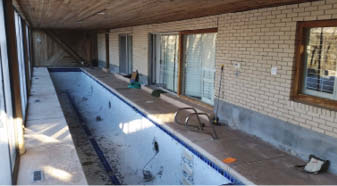 |
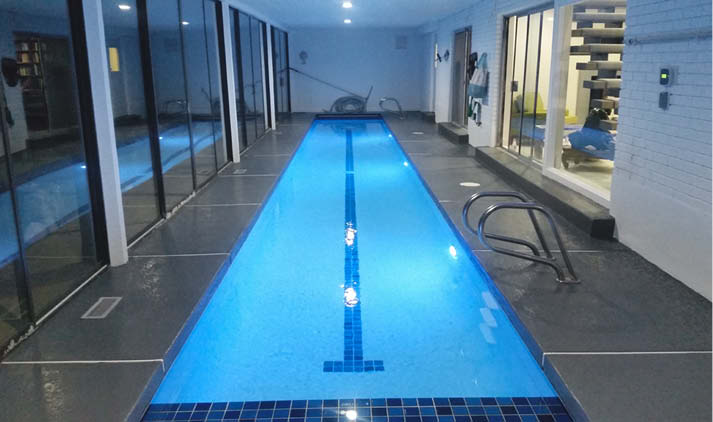 |
The medium-gray stain was combined with white paint on the ceiling and adjacent walls in a design specified by the owner, a residential builder and rehabber who “really knows his color,” Langston says. “No one believed the owner that the medium gray would look good, but he was ahead of the ‘gray trend’ that’s hot right now.”
The pool project was part of an extensive rehab of the entire residence. Langston also painted the cedar-wood ceiling above the pool, and adjacent window and door trim, with a stain-blocking primer and white topcoat.
Proven where it counts
Ogden sticks with products and materials he knows, but says he’s not resistant to new and better products.
“Coatings have come a long way and coloring systems are starting to become reliable. Acid stains are very dependable inside and out. I have been resistant to water-based anything. In the early years they were just paint and later did not bond well.
Ogden formulates color-restoration approaches that aren’t necessarily industry standards but have been proven to work. “Sometimes,” he says, “they are the only way possible with budget restraints.”
Case in point: Ogden says he’ll color on top of coatings, which many contractors hesitate to do. But, he says, the methods and products he uses are very specific. Plus, he emphasizes the importance of owners being aware of long-term maintenance requirements.
For example, he’ll color with Smith Paint Products’ concrete stains on top of solvent-based acrylics or epoxies. The stain must dry a minimum of 24 hours, as specified by the manufacturer. Once the stain has dried — “and there are no exceptions to this requirement” — the surface must be top-coated with a sealer of the contractor’s choosing. Performance and color retention will depend on the coating’s maintenance, he says.
He uses acetone dyes in much the same way, but again, the clear coat on top determines long-term color performance, he says. Acetone offers the advantage of rapid dry.
Grinding as a prep method has greatly enhanced the performance of water- and acetone-based colors, Ogden says.
“Since we have started grinding floors to prepare them for stains and dyes, the performance has changed dramatically,” he says. “Coatings will bond and water-based products have become reliable. And in this industry, without reliability you have nothing but problems.”
Restoration vs. new surface
Kevin Brown, an Eastvale, California, contractor who regularly finds himself on rescue missions involving decorative concrete that’s seen better days, describes a recent project where a whole new surface — in the form of an overlay — was the prescribed solution.
The original concrete, an acid-stained walkway leading from the street to the home, was old and tired. The owner also wanted an entirely different look. Although KB Concrete Staining has successfully executed color-restoration work using NewLook International stains, Brown pitched using an overlay to deliver this “different” look.
Following a surface grind as prep, he installed Super-Stamp Gray. He then textured this Super-Krete product — a cementitious, polymer-modified stampable overlay applied with trowel and gauge rake — with ProLine Seamless Old Granite Cleft Stone.
The next day, he made narrow, decorative saw cuts designed to produce a “clean, precise” look as opposed to the original surface’s wide cuts that looked dated.
Brown then stained the borders dark and the adjacent areas a lighter color with NewLook TiqueWash, water-based antiquing stains that produce a natural-looking, multitoned finish on textured concrete. He sealed it all with a solvent-based clear sealer from NewLook.
Sidewalks feel the love
On a nearby, winding sidewalk, Brown recommended applying new colors where the original color was woefully faded. After cleaning the surface with an eco-friendly detergent and power-washing it, the crew applied a solid base color. They then sprayed several transparent colors on top of that to create a faux finish look. They also brushed a solid-color stain on the joints to accent them.
In another project, a seamless stamped, faded and weathered pool deck and coping had taken on the mottled appearance that integral colors can exhibit over time, Brown says.
“With integrally colored concrete, the color can vary as cure proceeds, giving a nonuniform appearance from trapped moisture and air in the concrete. This becomes more apparent with age,” Brown says.
Brown cleaned the surface with NewLook’s 3-in-1 Prep, an eco-friendly, citrus-based acid cleansing detergent, before pressure-washing it. Two light earth-color water-based transparent stains were used on the deck’s field areas, with a darker, contrasting solid-color water-based stain for the coping and adjacent wall caps.
A water-based aliphatic urethane sealer was used on the wall caps and copings, while a solvent-based gloss sealer that enhances the look of the surface was used on the deck field areas.
Formulating the right prescription

Bryan Lassiter, general manager of Ardor Solutions in Oklahoma City, says the company has successfully restored or added color to existing concrete using Revive Exterior Concrete Stain, a penetrating siloxane product from Scofield, now a Sika brand.
He cites a recent project where a hospital in Oklahoma City needed to remedy an exterior concrete plaza that had been stained and sealed a few years earlier. The sealer had created a slippery surface, and salt used for de-icing had deteriorated the colored concrete’s appearance. At the same time, the owner wanted a surface that wouldn’t require frequent sealer application going forward.
The surface featured score patterns and colors. Ardor Solutions worked to match the original colors, which had faded somewhat, Lassiter says. Some new concrete also had been poured as part of a drainage-system change.
Ardor Solutions sandblasted the entire concrete surface to make it nonslip, then applied Revive to stain both the existing colored surface and the new, gray concrete. UV stability was another plus for the stain, he says. No sealer was used, although it is an option, Lassiter notes.
Oklahoma City Zoo
In another project, the Oklahoma City Zoo decided it wanted color added to the gray concrete in one of its exhibits. Here, the owner sought a finish that was more durable than a topical treatment and more akin with the monolithic, opaque appearance of integral color. Lassiter fulfilled that request with Revive, a formula that’s “really a penetrating base they add pigment to,” he says.
In the zoo project, Scofield’s Repello Water & Stain Repellant, a proprietary acrylic blend, was applied over the exterior stain. A dose of extra protection, says Lassiter, was in order in this demanding environment.
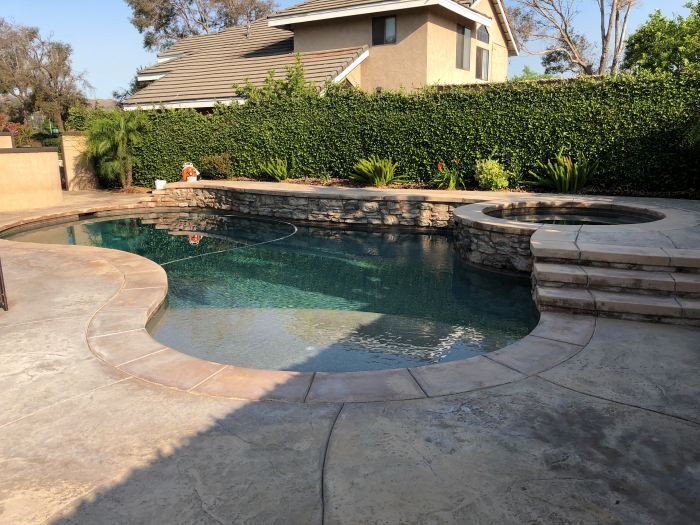 |
 |
Color refresh and reseal
Scott Kunkel, of Kunkel Floor & Surface Care in Fort Wayne, Indiana, offers a tour through his company’s “Clean, Color Refresh and Reseal” treatment in a project for a real-estate management firm involving a stamped and colored concrete walkway leading to a property’s front door. The walkway’s original color treatment and sealer had degraded and faded extensively.
During inspection, Kunkel’s crew noticed areas where the original color and acrylic sealer remained intact. Elsewhere, on about half the area, both the color and sealer had totally worn off.
Kunkel’s team set about cleaning the surface by scrubbing it with a Simple Green and water solution. They then used a deck brush to loosen dirt and residue. They then rinced the area clean with a robust 4,000-psi pressure wash and dried for about 24 hours.
For the color-refresh part of the project, the crew protected the surrounding brick, driveway, landscape and grass from overspray. They then applied one saturated coat of a light charcoal Liquid Colored Antique Concrete Stain from Direct Colors with a garden-grade plastic pump sprayer.
The surface dried again for about 24 hours. At this point, it was evident that the remaining acrylic sealer wasn’t flaking and was still well bonded to the concrete surface. Due to the mineral spirits carrier in the stain, the material bonds to both the exposed concrete and the existing sealer. This means stripping the remaining sealer wasn’t necessary, Kunkel says.
The crew then applied two thin coats of a Direct Colors satin-finish, outdoor acrylic concrete sealer to the entire recolored surface.

Profiting from specialization
John Pla is head of a stable of business units in Southern California that includes the RestoraCrete brand. He says there’s relatively little new under the sun regarding color-restoration methods and materials.
The real story, Pla contends, is what contractors can do on the marketing and business side of things — presenting themselves as specialists who focus on expertise in certain facets of the trade.
For example, staining pool coping is a niche, as is staining stamped concrete and concrete pavers, he says. You can market expertise in one or more, with reputations built and value added.
Business model and marketing approaches aside, Pla also gives high marks to the NewLook International color-restoration portfolio. He says it delivers highly predictable staining results.
“Customers today want specialized contractors,” not contractors who stain old weathered decorative concrete one day and pour sidewalks the next. “Promoting the fact that you have specific knowledge on a particular type of ‘pain’ increases consumer confidence and inherently increases sales,” he says.
“Specialization is where margin and a company’s foundation grow best. You can’t build a strong brand doing everything.”
Pla talks about “scale” within these specializations. “Contractors, for fear of not having work, will naturally do the shotgun approach to their service menu, which without intention limits their ability to grow and scale the business.”
Play to your market
Still, Pla adds, what works in his market area in Southern California will not be the same in other parts of the country. In Florida, for example, pavers are the story, “so it may make sense to focus there.” Still, other geographic regions may not have the critical market mass to make such narrow specializations succeed.
He suggests that specialization also enhances the contractor’s ability to quantify a job’s anticipated time frame and cost, and tell the prospective customer upfront something about cost and project duration. At the same time, he continues, the contractor can “prequalify” potential clients without even visiting the site.
The “Upfront” contract approach
Pla calls this process an “upfront” contract. This is where the potential client gets an idea on cost and timing. And thus is ruled in or ruled out as a customer. “A perspective on respecting your customer’s time as well as placing a true value on your time is important.”
Pla says he’ll ask the interested caller: “We’re a month out. Does that meet your time frame?” Or, “On a scale from one to 10, where are you with your time frame?” He may even touch on budget. “Our average job is $2,500 to $3,500. Does that meet your budget?”
He’ll also give an “average” per-square-foot cost figure for this specialized service. This also comes with the warning that this can go higher if there’s more to the job. Then, if the caller takes a pass, the contractor saves himself the waste of time and expense of a site visit. If the caller remains interested, you can formulate a budget that nails down the specifics of what the client wants.
“Marketing in the future is here now, and working towards a progressive way to reach customers and interacting with them is just as important as any other part of your business,” he says.
Specialization can pay off
Bella Rocca’s Langston, on the other hand, says specialization can pay off if you have enough work and enjoy the type of work involved in the specialization.
“While I enjoy fun artistic pieces, they aren’t always the most profitable. It’s often the boring colors that cover large square footage that pays the bills.” Contractors often have a specialty but offer a range of services to keep a steady stream of work, Langston says.
But, he adds, “Higher-profile restoration work can help win larger contracts. This is because you’re able to show your attention to detail and your craftsmanship.”
Matching budget with project for successful outcome
Budget always figures extensively in any restoration project, KB Concrete Staining’s Brown says. He shows prospective clients a catalog of different approaches shown in images and with cost estimates per square foot.
“They may want something and not have the budget, or maybe it’s not technically feasible. They may want champagne but have to settle for a good beer.”
Brown says he evaluates the existing project site’s condition. If it’s still in good shape, he can do a lot with it without replacing the surface. Colors and materials available when they did projects years ago pale by comparison with what’s available now, he says. Today, he can combine a base color with transparent stains. This gives a whole new look to an aged concrete surface.
Getting on the same page
In working with owners and designers, Bella Rocca’s Langston says commercial or institutional facility managers typically know what they want when they reach out to you. “Still, I’ll often ask if they’d like some help in deciding colors,” he says.
“Most appreciate another opinion, and some will ask what other companies are doing with similar spaces. I have folders on my computer with various color combinations. I can quickly pull these up to help show the customer what certain colors look like in a variety of spaces.”
But, Langston cautions, “If you don’t feel you have an eye for style and color, don’t market that you do.” Instead, “Focus on your ability to deliver what they tell you they want.”
www.ardorsolutions.com
www.directcolors.com
www.getnewlook.com
www.kbconcretestaining.com
www.kunkelfloor.com
www.prolinestamps.com
www.restoracrete.com
www.scofield.com
www.simplegreen.com
www.smithpaints.com
www.super-krete.com
www.thebellarocca.com

